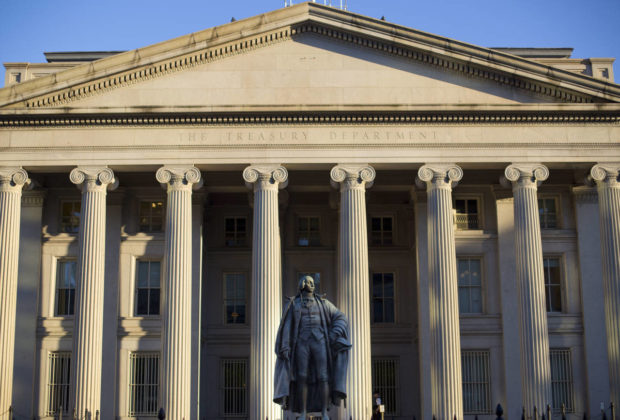The government surpassed a dubious milestone this week: Its debt topped $22 trillion — that’s trillion, with a “t″ — for the first time.
Piles of federal debt have been growing ever higher for years, fueled by accumulating annual deficits, which themselves have been driven by tax cuts, government spending increases and the mounting costs of Medicare and Social Security and interest on the debt itself.
Under President Donald Trump, the national debt has topped $20 trillion (September 2017) $21 trillion (March 2018) and now $22 trillion. As a presidential candidate, Trump had assailed the $1 trillion annual deficits under President Barack Obama and had said that as president he could wipe out all the debt. Now, Trump is projecting that his own annual deficits will top $1 trillion for a time.
So just what is the national debt, why does it keep rising and how worried should we be about it? Here are some questions and answers:
___
Q: What makes up the national debt?
A: It’s the total the government has borrowed to finance its operations beyond what it’s collected over the years in revenue from taxes and other sources. The debt has become a perennial source of hand-wringing because of, among other things, concern that it will paralyze the nation’s ability to finance its future operations and will hamstring generations to come. Not since the late 1990s and early 2000s has the U.S. government run a surplus, a luxury that allows it to reduce the debt and finance other needs.
___
Q: How does the debt differ from the deficit?
A: The deficit is the gap between what the government collects in revenue and what it spends in any particular budget year. The accumulation of these annual budget deficits, combined into one, represent the debt. Because the government typically spends more than it collects, it must borrow to make up the difference. For the 2018 budget year, which ended Sept. 30, the deficit totaled $779 billion. That was the largest gap between spending and revenue since 2012, when the deficit was $1.1 trillion. That year, during the Obama administration, the government had increased spending and cut taxes to continue stimulating the economy in the aftermath of the 2008 financial crisis and the Great Recession.
___
Q: Who holds all the debt the government has borrowed?
A: One misperception is that most of the U.S. debt is held by foreigners — in China, Japan and elsewhere. But in fact America’s biggest creditor is … America. Sixty-two percent of the federal debt is held in the United States — by the Federal Reserve, the Social Security system, banks, pension plans, mutual funds, insurance companies and individual investors.
In fact, the largest single chunk — $5.9 trillion, about one-fourth of the total — is money the government owes itself in the form of trust funds. The biggest is the Social Security trust fund. The government has drawn on this money, which is earmarked to pay Social Security benefits, to finance other expenses. But once that money is needed to pay Social Security benefits, the government must replenish the amounts it borrowed — with interest. If it’s still running deficits, the only way to do this is to take on more debt.
The debt held by the public — $16.2 trillion — is about three-fourths of the total. It’s held by investors in both the United States and abroad, ranging from individuals and pension funds to foreign central banks. China is the largest foreign owner of debt. It holds roughly $1.2 trillion in Treasury securities, followed by Japan, which holds about $1 trillion, according to the latest accounting.
___
Q: With interest rates still so low, how much concern is there about the size of the national debt?
A: That depends on whom you ask. Many economists say they fear that the rising debt represents a time bomb that will eventually explode and derail the economy. That is especially true, they argue, in light of projections that the annual deficits are once again headed above $1 trillion and will be stuck at those levels for years as the government pays the rising costs of Social Security benefits and Medicare health insurance for vast numbers of retiring baby boomers.
But some economists counter that with interest rates so low, the government shouldn’t be worried about reducing the deficits — at least not now. Instead, they contend, the government should focus on making worthwhile public investments in such areas as education, infrastructure, health care and environmental protections.
(AP)












2 Responses
1. To the extent that it is held by government agencies (e.g. the Social Security system), the Treasury could simply cancel the bonds and start funding the programs on a “pay as you go” basis, which would increase the deficits or require raising taxes.
2. The Congress could “monetarize” the debt by printing new money, which would cause inflation if done in excess.
3. As long as the US economy is strong and the currency is strong, financing the debt is no problem, But this too will pass, and at some point in time the US economy will be less strong, the currency weaker, inflation will be higher, and interests rates will rise, and then there will be a problem.
akuperma’s comment no. 1 sounds like Trump’s business strategy: when the bill comes due, don’t pay it. It works for a very short while, then it doesn’t. One well-reported example is how Trump stiffed the folks who sold about 100 pianos to his casinos, and he paid for 80. Trump did the same thing with bank creditors, and that forced him out of the construction business.
The US Treasury and its notes and bonds are the soundest in the world, because it does not “simply cancel the bonds”. If you want to turn the US into Greece, all you have to do is dishonor US debt.